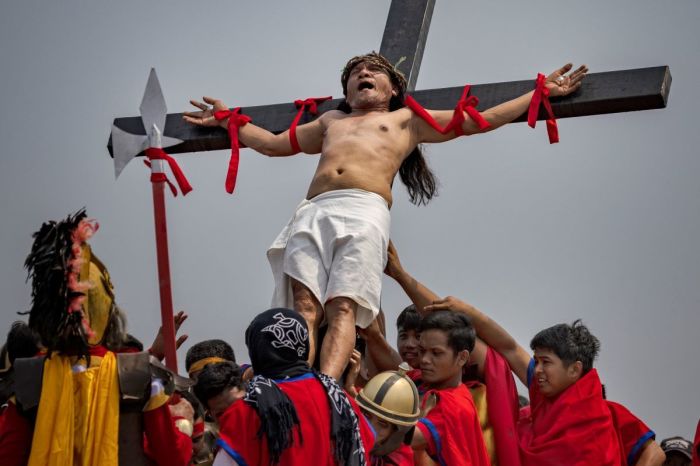Filipinos resume Good Friday crucifixion reenactments after COVID-19 pause

Despite warnings from health officials and objections from the Catholic church, Filipinos were nailed to crosses this Good Friday as the nation continued its controversial tradition of reenacting the crucifixion of Christ.
In San Fernando, Pampanga, Wilfredo Salvador had his hands and feet nailed to a cross on Friday. The Philippine News Agency reports that the 66-year-old fisherman went through the act to thank Christ for helping him overcome a mental breakdown 15 years ago.
According to The Associated Press, about eight men participated as crucifixions resumed in the farming village of San Pedro Cutud in Pampanga, north of Manila, for the first time in three years. Among those who participated in the brief display was 62-year-old sign painter Ruben Enaje.
"To be honest, I always feel nervous because I could end up dead on the cross," he told AP before the event. "When I'm laid down on the cross, my body begins to feel cold. ... When my hands are tied, I just close my eyes and tell myself, 'I can do this. I can do this.'"
The health department of Asia's largest Catholic nation urged worshipers to avoid the traditions of crucifixion and self-flagellation as part of the country's observance of Holy Week due to the risk of tetanus and other infections.
"First of all, you could get tetanus when you are crucified," Department of Health Officer-in-Charge Maria Rosario Vergeire said at a press conference on Tuesday, according to The Daily Tribune. "You may also get tetanus from flagellation due to the (dirt) at the end of some whips used for the beating."
Filipinos were cautioned against the national tradition of kissing religious statues, which officials said could also spread other diseases.
One of the country's longstanding practices, known as pahalik, involves kissing a statue of the dead body of Christ.
"We don't have any restrictions regarding the kissing of religious statues," said Vergeire. "As I've said, we can do the things that we usually do. However, each of us should know how to take care of ourselves."
This year's ceremonies marked a return to tradition following a three-year pause due to the COVID-19 pandemic.
As part of the decades-old Lenten ceremony, participants reenact Christ's crucifixion as villagers in the city of San Fernando in the Philippines' province of Pampanga dressed as Roman centurions hammer steel nails about four inches long through their palms before lifting them up on the crosses before the crowd.
A Christian devotee named Wilfredo Salvador has been nailed to a cross and a Crown of Thorns placed on his head during the re-enactment of the crucifixion of Jesus Christ on Good Friday in Pampanga province in the Philippines on April 7, 2023. #eyeradioupdates#SSOT. | ???? AFP. pic.twitter.com/p0HUfhnVxA
— Eye Radio (@EyeRadioJuba) April 7, 2023
Other participants engage in self-flagellation and crawling on rough pavement. Some in the past have cut open the backs of other participants to "ensure the ritual was sufficiently bloody," according to AP.
The tradition began in earnest in 1962 with the actual crucifixion of a San Fernando resident who officials called "a quack doctor who dreamt that he would become a religious leader and full-fledge (sic) healer."
Since then, some participants have been crucified dozens of times, many taking a vow of sacrifice known as panata.
Despite the longtime practice, the Roman Catholic church has been a vocal opponent of crucifixion, even as an act of worship.
Church leaders have previously called the ritual "self-serving" and corrupting Christ's message of suffering for others.
"Penance does not mean you hurt yourself, because your body is a temple that houses the spirit," Archbishop Emeritus Aniceto Paciano of San Fernando told Reuters at the time.
Following a 2013 reenactment, Auxiliary Bishop Pablo Virgilio David said that the church is unable to stop the practice.
"I do not think it is right to close our doors to them just because they are more attracted to these folk practices than to our Roman liturgy, which they may find too foreign or cerebral," he told Reuters.
Bishop Joel Baylon of Legazpi, chairman of the bishops' commission on youth, believes there are "other forms of sacrifice and suffering that would lead to real conversion."
"The Lord appreciates all these forms of sacrifices, but sometimes the kind of sacrifice that we impose on ourselves is not what the Lord wants us to do," Baylon said.





























